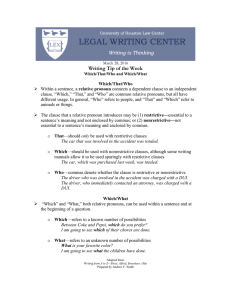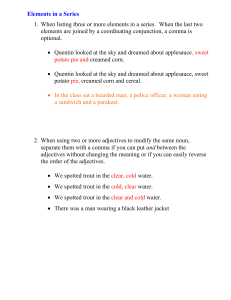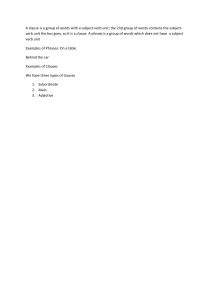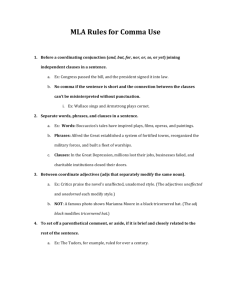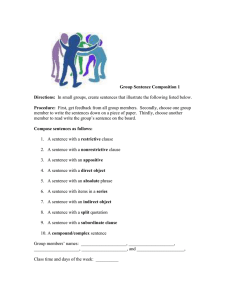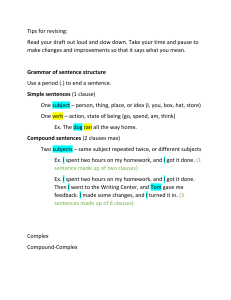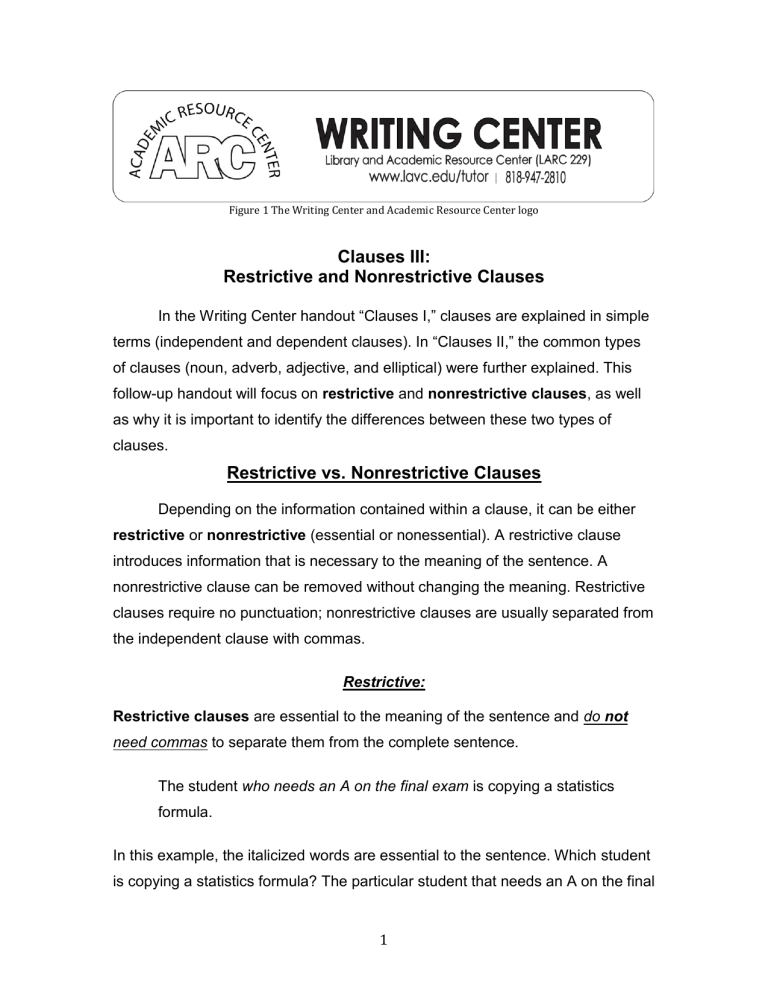
Figure 1 The Writing Center and Academic Resource Center logo Clauses III: Restrictive and Nonrestrictive Clauses In the Writing Center handout “Clauses I,” clauses are explained in simple terms (independent and dependent clauses). In “Clauses II,” the common types of clauses (noun, adverb, adjective, and elliptical) were further explained. This follow-up handout will focus on restrictive and nonrestrictive clauses, as well as why it is important to identify the differences between these two types of clauses. Restrictive vs. Nonrestrictive Clauses Depending on the information contained within a clause, it can be either restrictive or nonrestrictive (essential or nonessential). A restrictive clause introduces information that is necessary to the meaning of the sentence. A nonrestrictive clause can be removed without changing the meaning. Restrictive clauses require no punctuation; nonrestrictive clauses are usually separated from the independent clause with commas. Restrictive: Restrictive clauses are essential to the meaning of the sentence and do not need commas to separate them from the complete sentence. The student who needs an A on the final exam is copying a statistics formula. In this example, the italicized words are essential to the sentence. Which student is copying a statistics formula? The particular student that needs an A on the final 1 exam. No comma is needed because the context clarifies that “who needs an A on the final exam” is necessary to clarify the subject, “the student.” Freddy hopes to return to the city where he met Jessica. Again, the italicized words are essential to the sentence. Which city does Freddy hope to return to? The particular city where he met Jessica. These clauses contain information that is essential to identify the noun they follow, as well as to clarify the context of the sentence. More examples: The man who ordered another anchovy pizza claims to have a pet dog. John walked to the park where the baby deer lived. Nonrestrictive: Nonrestrictive clauses are not essential to the meaning of the sentence and do need commas to separate them from the complete sentence. Veronica, who needs an A on the final exam, is copying a statistics formula. In this example, the italicized words are considered extra information and could be deleted. Paying attention to the context clarifies which clauses are nonessential. The real point of the first sentence is that Veronica is copying a statistics formula. The fact that she needs an A on the final exam is extra information. Freddy hopes to return to Tokyo, where he met Jessica. Again, the italicized words reference extra information. The focus of the second sentence is that Freddy hopes to return to Tokyo, where it just happens that he met Jessica. This information is nonessential to the sentence and is therefore nonrestrictive. Again, it is important to pay attention to the context of the sentence. 2 NOTE! Notice that proper nouns tend to replace vague nouns in nonrestrictive clauses. For example, see the difference between “The student” from an earlier example and “Veronica” from the recent Figure 2 A push pin example? The first is a vague noun, while the latter is a proper noun. Clauses in which proper nouns (such as Susan, London, Microsoft, etc.) are the subject typically require the use of a nonrestrictive clause. More examples: Jessica, who turned fifteen last year, bought a car of her own. The city, which was founded by John Reagan in 1978, has grown tremendously in the past 30 years. The pie was baked last Sunday, which means that it is probably spoiled today. That vs. Which In general, “that” is used for restrictive clauses and “which” is used for nonrestrictive. Notice the difference in the following sentences: The team that won the game is my favorite. The team, which won the game, is my favorite. In the first sentence, the fact that the team won the game is important because it specifies which team. The second sentence treats the same information as not necessary in the sentence; in this case, the second sentence would be used only if the reader already knows what team is being referred to. Chairs that don’t have cushions are uncomfortable to sit on. Chairs, which are found in many places of work, are often uncomfortable to sit on. 3 In the first sentence, the fact that the chairs don’t have cushions is something essential to the sentence; it is a clause that directly identifies the subject. (Which chairs? The ones that don’t have cushions.) In the second sentence, the fact that the chairs are found in many places of work is treated as extra information. (Which chairs? The chairs that are uncomfortable to sit on, which happen to be in many places of work.) In both of these cases, that identifies a restrictive clause with essential information, while which identifies a nonrestrictive clause with nonessential information. Interchangeable Restrictive and Nonrestrictive Elements: For further thought: What happens when restrictive and nonrestrictive clauses are interchangable? The meaning of the Figure 3 A push pin sentence can change depending on whether a restrictive or nonrestrictive element is used. For example: He helped the native guides who were sick with malaria. No comma is used before “who,” making this a restrictive clause. This tells the reader that not all the guides had malaria. He helped the native guides, who were sick with malaria. Putting the comma before “who” makes what follows a non-restrictive clause. In addition, this changes the sentence to mean that all the guides had malaria. Another example: My brother, Ken, worked for a TV ratings company. Adding commas around “extra” information in this sentence indicates that I have only one brother, and his name is Ken. Due to the fact that I only have one brother, his name is a nonrestrictive element or nonessential to the meaning of 4 the sentence. You don't need his name to know the exact person that I am talking about. Therefore, it is set off by commas. My brother Ken worked for a TV ratings company. In this case, excluding commas makes Ken’s name a restrictive element. This sentence hints that I have more than one brother, and it's essential to know his name to avoid confusion about the brother that I am referencing. In this case, a comma is not needed. Exercises 1. Is the clause in the sentence restrictive (R) or nonrestrictive (N-R)? I want to buy the socks that are red. R N-R The store, where we usually buy groceries, is closed. R She is crying, which means she is sad. R N-R N-R The lecture that we must attend has already begun. R N-R 2. Complete the sentences using restrictive clauses only. I want to buy the jacket ___________________________________________________. Sarah left to find the one __________________________________________________. The students __________________________________ always receive fabulous grades. The food _______________________________________________ has disappeared! 3. Complete the sentences using nonrestrictive clauses only. The student went to the store, _______________________________________________. John Wayne, _______________________________, made millions of dollars as an actor. 5 My favorite book, ______________________________, is about mothers and daughters. Jessica left for the public library, ____________________________________________. For answers to these exercises, please consult with a Writing Center tutor. This handout is based on the following sources: Beason, Larry, and Mark Lester. A Commonsense Guide to Grammar and Usage. Boston, MA: Bedford/St. Martin's, 2006. Print. The Tongue Untied: A Guide to Grammar, Punctuation, and Style. Ed. Kellee Weinhold. 2008. University of Oregon. 20 April 2010. <http://www.grammaruntied.com> Wyatt, C.S. “Clauses and Phrases”. Tameri Guide for Writers. Ed. S.D. Schnelbach. 12 September 2009. 27 April 2010. <http://www.tameri.com/edit/phrases.html> For further reference, see the following books: Azar, Betty Schrampfer. Understanding and Using English Grammar. New Jersey: Prentice Hall Regents, 1989. All of the above texts are available in the Writing Center. For more information, please visit our website at http://www.lavc.edu/writingcenter/ Last Revised: 6/18/2018 6
